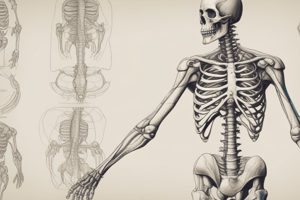Podcast
Questions and Answers
¿Cuál es el propósito principal del esqueleto axial?
¿Cuál es el propósito principal del esqueleto axial?
- Proporcionar puntos de unión para los músculos
- Regular la temperatura corporal
- Proteger el cerebro y la médula espinal (correct)
- Apoyar el movimiento y la locomoción
¿Cuántos huesos tiene el esqueleto axial?
¿Cuántos huesos tiene el esqueleto axial?
- 106 huesos
- 50 huesos
- 126 huesos
- 80 huesos (correct)
¿Cuál es la característica principal de los huesos cortos?
¿Cuál es la característica principal de los huesos cortos?
- Son curvos y flexibles
- Son cubicos o rectangulares (correct)
- Son gruesos y pesados
- Son largos y delgados
¿Qué tipo de huesos son las costillas?
¿Qué tipo de huesos son las costillas?
¿Cuál es la función principal del esqueleto apendicular?
¿Cuál es la función principal del esqueleto apendicular?
¿Cuál es la característica principal de los huesos largos?
¿Cuál es la característica principal de los huesos largos?
¿Cuántos huesos tiene el esqueleto apendicular?
¿Cuántos huesos tiene el esqueleto apendicular?
¿Qué tipo de huesos son el fémur y la tibia?
¿Qué tipo de huesos son el fémur y la tibia?
Flashcards are hidden until you start studying
Study Notes
Esqueleto Axial
- Composed of 80 bones that form the central axis of the body
- Divided into three parts: skull, vertebral column, and thoracic cage
- Bones of the axial skeleton:
- 22 bones in the skull
- 33 bones in the vertebral column
- 28 bones in the thoracic cage
- Functions:
- Protects the brain and spinal cord
- Supports the head, neck, and torso
- Provides attachment points for muscles
Esqueleto Apendicular
- Composed of 126 bones that form the upper and lower limbs
- Divided into two parts: upper limb and lower limb
- Bones of the appendicular skeleton:
- 64 bones in the upper limb (scapula, humerus, radius, ulna, carpals, metacarpals, and phalanges)
- 62 bones in the lower limb (pelvis, femur, patella, tibia, fibula, tarsals, metatarsals, and phalanges)
- Functions:
- Supports movement and locomotion
- Provides attachment points for muscles
Huesos Cortos
- Short bones that provide support and stability
- Characteristics:
- Cube-shaped or rectangular
- Approximately equal length and width
- Examples:
- Carpals (wrist bones)
- Tarsals (ankle bones)
- Metacarpals and metatarsals (bones in the hands and feet)
Huesos Planos
- Flat bones that provide protection and support
- Characteristics:
- Thin and flat
- Often curved or bent
- Examples:
- Ribs
- Sternum (breastbone)
- Scapulae (shoulder blades)
- Cranium (bones of the skull)
Huesos Largos
- Long bones that provide leverage and support for movement
- Characteristics:
- Longer than they are wide
- Composed of a shaft (diaphysis) and two ends (epiphyses)
- Examples:
- Humerus (upper arm bone)
- Femur (thigh bone)
- Tibia and fibula (lower leg bones)
- Radius and ulna ( forearm bones)
Esqueleto Axial
- El esqueleto axial se compone de 80 huesos que forman el eje central del cuerpo
- Está dividido en tres partes: cráneo, columna vertebral y caja torácica
- Los huesos del esqueleto axial ofrecen protección al cerebro y la médula espinal
- También proporcionan soporte para la cabeza, cuello y torso
- Y brindan puntos de fijación para los músculos
Esqueleto Apendicular
- El esqueleto apendicular se compone de 126 huesos que forman las extremidades superiores e inferiores
- Está dividido en dos partes: miembro superior y miembro inferior
- Los huesos del esqueleto apendicular permiten el movimiento y la locomoción
- También brindan puntos de fijación para los músculos
Huesos Cortos
- Los huesos cortos son huesos que proporcionan soporte y estabilidad
- Características: tienen forma de cubo o rectangular, y tienen una longitud y anchura aproximadamente iguales
- Ejemplos: carpos (huesos de la muñeca), tarsos (huesos del tobillo), metacarpianos y metatarsianos (huesos de las manos y pies)
Huesos Planos
- Los huesos planos son huesos que proporcionan protección y soporte
- Características: son delgados y planos, y a menudo curvados o doblados
- Ejemplos: costillas, esternón (hueso del pecho), escápulas (huesos de la espalda), cráneo (huesos del cráneo)
Huesos Largos
- Los huesos largos son huesos que proporcionan palanca y soporte para el movimiento
- Características: son más largos que anchos, y se componen de una diáfisis (eje) y dos epífisis (extremos)
- Ejemplos: húmero (hueso del brazo), fémur (hueso del muslo), tibia y fibula (huesos de la pierna), radio y ulna (huesos del antebrazo)
Studying That Suits You
Use AI to generate personalized quizzes and flashcards to suit your learning preferences.



